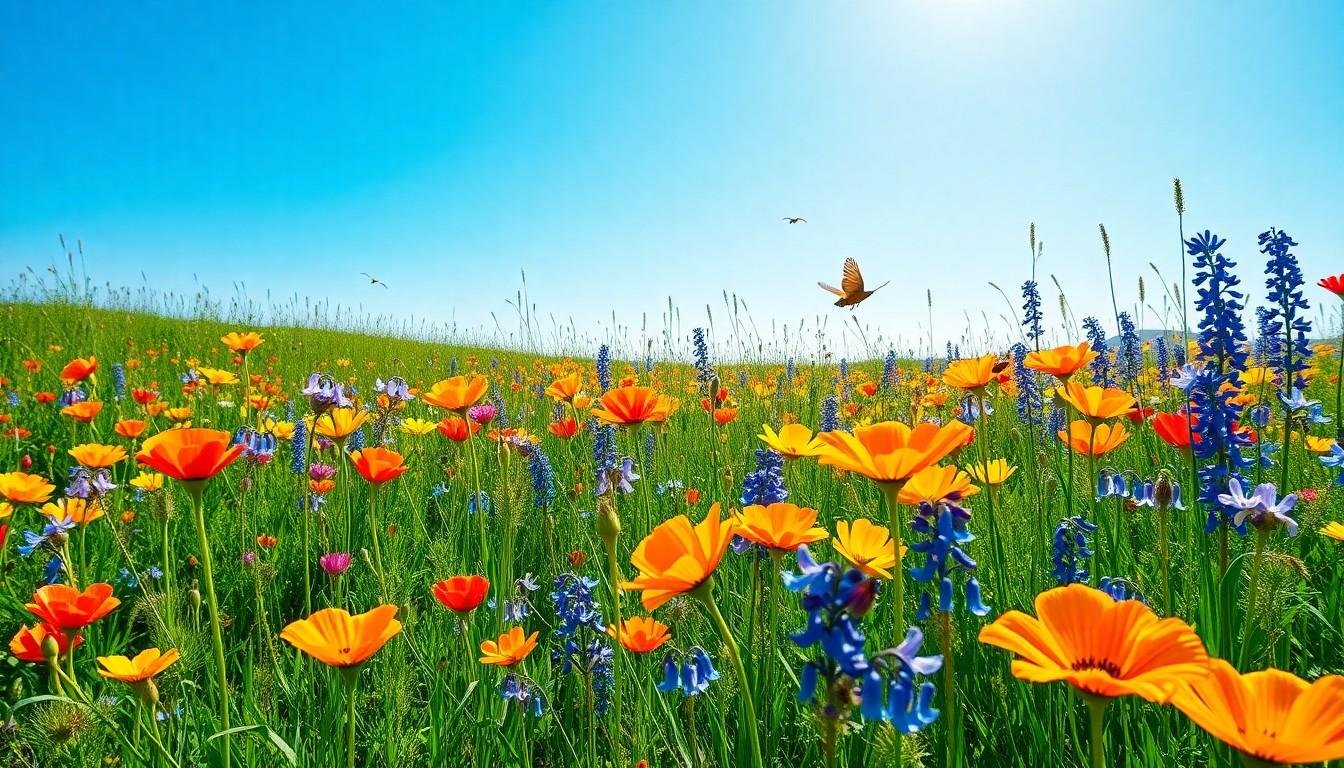The Best Fluffy Pancakes recipe you will fall in love with. Full of tips and tricks to help you make the best pancakes.

Spring Wild Flowers: Discover Nature’s Colorful Awakening and Joyful Blooms
As winter reluctantly releases its icy grip, a vibrant spectacle begins to unfold across the landscape. Spring wildflowers burst into bloom, transforming dull fields into a riot of colors that could make even a rainbow blush. These little nature artists don’t just brighten the scenery; they also bring joy and a sense of renewal that’s hard to resist.
Imagine strolling through a meadow, surrounded by a kaleidoscope of petals, each one whispering, “Stop and smell me!” Whether it’s the delicate bluebells or the cheerful daisies, these blooms have a knack for lifting spirits and sparking creativity. So grab your camera and prepare to be dazzled—spring wildflowers are nature’s way of reminding everyone that beauty is just around the corner.
Overview of Spring Wild Flowers
Spring wildflowers emerge as a vibrant symbol of renewal. Various species bloom across meadows, forests, and fields, each showcasing unique colors and shapes. Daffodils, tulips, and violets are common early indicators of spring’s arrival, often found pushing through the thawed soil. These enchanting blooms attract both pollinators and admirers, creating lively ecological interactions.
The diversity in spring wildflowers spans various ecosystems. California poppies thrive in arid conditions, while bluebells favor shaded woodlands. Wildflower species adapt to local climates, ensuring a rich tapestry of color during spring months. Each flower contributes to its environment, supporting local wildlife and fostering biodiversity.
Spring’s wildflowers also create significant cultural and practical importance. Many civilizations celebrate these blooms through festivals and art, linking nature to community spirit. Some species, like chamomile and elderflower, offer culinary or medicinal benefits. Understanding these flowers enhances appreciation for their roles in nature and human life.
Timing plays a crucial role in the blooming process. As temperatures warm, wildflowers typically begin to open from late March through June. Recognizing these stages allows enthusiasts to enjoy each species at its peak. Wildflower hotspots across the U.S. host events inviting exploration of this seasonal beauty.
These factors collectively highlight the allure of spring wildflowers. Viewing and studying them fosters an appreciation for nature’s cycles. Observers often find joy in their presence while gaining insight into ecosystems and seasonal changes.
Types of Spring Wild Flowers

Spring showcases a variety of wildflower species, with native and non-native options enriching landscapes across the U.S. Each type plays a unique role in the ecosystem.
Native Species
Native wildflowers thrive in local ecosystems, contributing to biodiversity. Examples include the vibrant purple coneflower, which attracts pollinators, and the fragrant wild bluebell, known for its stunning blue hue. Other notable plants are the butterfly weed and prairie dogbane, each supporting important wildlife. When present in natural habitats, these species provide essential resources for native insects and birds. Conservation of native wildflowers fosters a healthy environment and sustains the regional flora and fauna.
Non-Native Species
Non-native wildflowers add a splash of color to spring landscapes. The cheerful daffodil, often seen in gardens, brightens up spaces with its yellow blooms. Gardeners frequently plant tulips for their striking variety and resilience. Another popular choice is the California poppy, which although native to California, can flourish in other regions. These species can enhance visual appeal but may compete with native plants if not managed properly. Careful selection of non-native wildflowers minimizes potential ecological disruption while still celebrating spring’s beauty.
Growing Conditions for Spring Wild Flowers
Growing spring wildflowers requires attention to specific conditions. Understanding these factors ensures healthy blooms and vibrant displays.
Soil Requirements
Well-draining soil forms the foundation for successful wildflower growth. Plenty of wildflowers thrive in sandy or loamy soils with a pH level between 6.0 and 7.0. Adding organic matter helps improve soil fertility. Native species prefer less-compacted soils, enhancing root development. Amending soil with compost boosts nutrient levels, promoting strong growth in plants like purple coneflowers and wild bluebells. Regular testing can determine soil conditions, ensuring optimal environments for various spring blooms.
Sunlight and Water Needs
Sunlight exposure is critical for flourishing spring wildflowers. Generally, most species require full sun, meaning six hours or more of direct sunlight daily. This light supports photosynthesis, leading to robust growth. Water is equally important, with a moderate moisture level required for healthy plants. Species such as California poppies prefer well-drained, dry conditions while enjoying periodic watering during dry spells. Over-watering can lead to root rot, so maintaining a balance is essential for flower health. Adjusting water based on climate and soil type helps cultivate vibrant wildflower gardens.
Benefits of Spring Wild Flowers
Spring wildflowers offer numerous benefits that enrich both ecosystems and human experiences.
Ecological Impact
Spring wildflowers play a crucial role in supporting local ecosystems. They provide essential food sources for pollinators like bees and butterflies, which are vital for plant reproduction. Native wildflowers contribute to healthier soil and improve its structure by preventing erosion. They also promote biodiversity by offering habitat for various species, enhancing the resilience of ecosystems. Non-native species can sometimes disrupt local habitats, yet their careful management can contribute to ornamental diversity without harming native plants. Overall, these flowers foster ecological interactions that sustain the health of the environment.
Aesthetic Value
The aesthetic appeal of spring wildflowers cannot be overstated. Their vibrant colors create stunning landscapes that attract visitors to natural areas. Gardeners and landscapers often incorporate these flowers to enhance the beauty of outdoor spaces. Wildflowers evoke feelings of joy and renewal, inspiring artists and photographers alike. Seasonal blooms, such as daisies and poppies, add dynamic charm to meadows and parks, inviting people to explore nature. This beauty not only uplifts spirits but also encourages a deeper appreciation for the environment, fostering a connection to nature’s wonders.
Conclusion
Spring wildflowers bring a burst of color and life to the landscape, reminding everyone of nature’s beauty and resilience. Their ability to uplift spirits and inspire creativity makes them a cherished part of the season.
Exploring meadows filled with these blooms offers a chance to connect with the environment and appreciate the vital role these flowers play in supporting local ecosystems. By understanding the differences between native and non-native species, individuals can make informed choices that enhance their gardens while preserving biodiversity.
As spring unfolds, the vibrant display of wildflowers invites everyone to step outside and experience the joy and renewal that this season has to offer. Embracing the beauty of wildflowers enriches the soul and fosters a deeper appreciation for the natural world.
